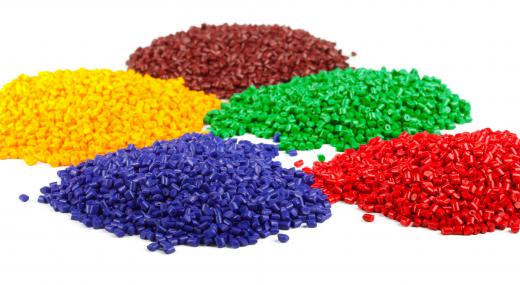To find out which types of plastic can be recycled in the local area, it may be best to contact the local municipal offices or recycling centers; most of these offices and centers have websites with contact information, such as email addresses or phone numbers, posted on their webpage, or they may include a list of recyclable plastics on their site as well. When contacting such facilities, it is suggested to first locate the plastic's resin identification code; this code is made up of one number and several letters, and is usually located on the bottom of the product. The code corresponds to the type of plastic that the object is made of and can be referred to when asking the proper agency if the plastic is recyclable or not.
Resin Identification Code

To help identify and sort recyclable plastic internationally, the Society of the Plastics Industry (SPI) developed a standard code in the late 1980s. This code simply identifies the type of plastic used to make that object; however, it does not indicate whether recyclable plastic was used to make that piece, nor does it indicate whether that type of plastic can be recycled. Generally located on the bottom of the plastic container, the code consists of three arrows that cycle clockwise and create a triangle with rounded corners. Inside each triangle is a number that identifies that plastic's type, and below each triangle is a combination of letters that correspond to the scientific name of the type of plastic. Once the resin code is identified, one can contact local government or recycling agencies to ask if that code corresponds to a type of recyclable plastic.
There are seven different types of plastic identified by the American Society of Plastics Industry:
- 1 PET or PETE (Polyethylene terephthalate): PET is one of the most frequently recycled plastics by consumers. Containers marked with a "1" and "PET" or "PETE" include some soft drink bottles, water bottles, plastic peanut butter jars, plastic wrap, and salad dressing bottles.
- 2 HDPE (High-density polyethylene): This type of recyclable plastic, marked with a "2" and "HDPE" is also frequently recycled by consumers. Plastics included in this category include some plastic milk cartons, juice bottles, shampoo bottles, and liquid detergent containers.
- 3 PVC (Polyvinyl chloride): Marked by a "3" and "PVC," this type of plastic is less commonly accepted at local recycling centers because it is more difficult to recycle. Common examples include clear food packages, liquid detergent containers, and many construction applications including some traffic cones.
- 4 LDPE (Low density polyethylene): Marked with a "4" and "LDPE," this type of recyclable plastic is used in some bread and frozen food bags, trash cans, and garbage can liners.
- 5 PP (Polypropylene): One plastic commonly used in the automobile and construction industries, is polypropylene; this plastic is marked with a "5" and "PP." A few examples include some car battery casings, oil funnels, and plastic drinking straws.
- 6 PS (Polystyrene): Another type of recyclable plastic that is uncommonly used by consumers is polystyrene. Marked by a "6" and "PS," this plastic is used in some packing foam, plastic cutlery, and protective packaging for electronic goods and toys.
- 7 Other: Some types of plastic marked as "other," "O," or with a "7" cannot be recycled as they are commonly made with a combination of the previous six types of plastic, or with a type of plastic other than the six listed above, and can't be broken down to be recycled. Common examples are headlight lenses and safety glasses; however, containers marked with a "7" that are recyclable plastic include some three- to five-gallon reusable water bottles.

While there are many different types of plastics, not all of them can be recycled, and some of those that can may not be eligible for curbside pick-up or accepted at the local recycling location. Of the types of plastic that can be recycled, it is critical that they be recycled with their own kind because a small amount of the wrong type of plastic can ruin the melt. Therefore, sorting plastic is a critical part of the recycling process; many cities offer bins to help residents sort recyclables properly.
